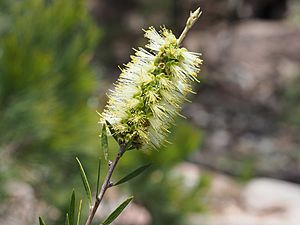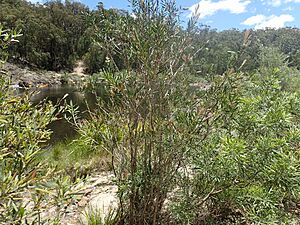Green bottlebrush facts for kids
Quick facts for kids Green bottlebrush |
|
|---|---|
 |
|
| Melaleuca flavovirens leaves and flowers | |
| Scientific classification | |
| Genus: |
Melaleuca
|
| Species: |
flavovirens
|
| Synonyms | |
|
|
The green bottlebrush (scientific name: Melaleuca flavovirens) is a special plant. It belongs to the Myrtaceae family, which also includes eucalyptus trees. This plant is found only in a small area of Australia, near the border between New South Wales and Queensland. It's known for its new leaves, which look silvery, and its unique greenish flowers with yellow tips. Some plant experts still call it Callistemon flavovirens.
Contents
What Does the Green Bottlebrush Look Like?
The green bottlebrush is a shrub that can grow from about 1 to 3 meters (3 to 10 feet) tall. It has tough bark that looks like it has ridges, almost like cardboard.
Its leaves are arranged one after another along the stem. They are about 3.6 to 10.2 centimeters (1.4 to 4 inches) long and 0.4 to 1.1 centimeters (0.2 to 0.4 inches) wide. The leaves are shaped like a narrow egg, with a blunt tip at the end. You can also see small oil glands on both sides of the leaves, and they have a clear middle vein with several side veins.
The flowers are usually white, cream, or green. They grow in spikes at the ends of branches, and sometimes on the sides too. These spikes can be up to 5.5 centimeters (2.2 inches) across and have 15 to 40 individual flowers. Each flower has 34 to 38 stamens (the parts that hold pollen), which are tipped with yellow. The petals are small, about 0.4 to 0.6 centimeters (0.15 to 0.24 inches) long, and they fall off as the flower gets older.
Green bottlebrush plants usually flower between May and December. After the flowers, the plant produces woody capsules, which are like small seed pods. These capsules are about 0.6 to 0.8 centimeters (0.2 to 0.3 inches) long.
How Was the Green Bottlebrush Named?
This plant was first officially described in 1925 by a scientist named Edwin Cheel. He first gave it a slightly different name, Callistemon rugulosus var. flavo-virens. Later that same year, he changed it to Callistemon flavovirens.
In 2006, another scientist, Lyndley Craven, changed its name again to Melaleuca flavovirens. This is the name it uses today.
The name flavovirens comes from two Latin words: flavus, which means "yellow," and virens, which means "green." This name describes the yellow tips on the green flowers of the plant.
Where Does the Green Bottlebrush Grow?
The green bottlebrush lives in the mountains and tablelands of northern New South Wales and southern Queensland. You can find it in places like Stanthorpe and Wallangarra in Queensland, and south to Torrington and the Guy Fawkes River National Park in New South Wales.
It likes to grow in scrubland, heath, and forest areas. You might see it near watercourses (small streams or rivers) or among large rocks on hilltops.
Is the Green Bottlebrush Protected?
Yes, in New South Wales, the green bottlebrush (known as Callistemon flavovirens there) is listed as a "Rare or Threatened Australian Plant." This means it's a special plant that needs protection because it's not very common and could be at risk.
Can We Grow the Green Bottlebrush?
The green bottlebrush is a tough plant that can handle dry conditions. It can also grow in wet places and can survive frosts. This makes it a good plant for gardens in some areas. You can grow new plants from its seeds or by taking cuttings (small pieces of the plant that can grow roots).
Gallery




